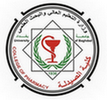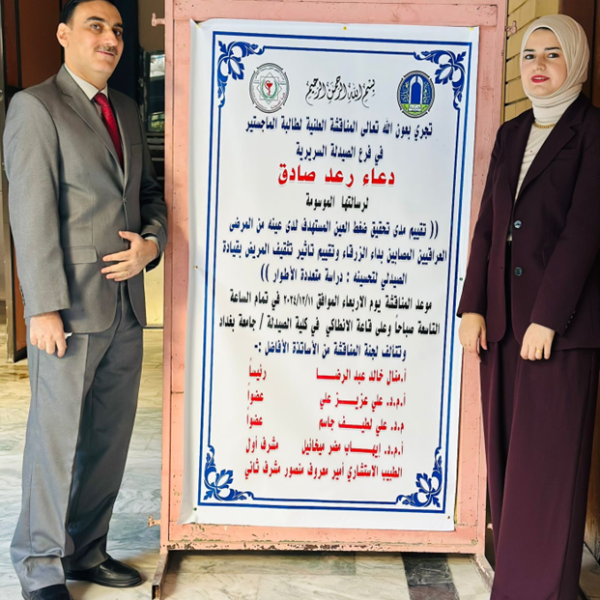The College of Pharmacy discussed the MSc thesis entitled “Assessment of the achievement of intraocular pressure target in a sample of Iraqi patients with glaucoma and evaluation of pharmacist-led education to improve it: A multi-phase study” by the student Duaa Raad Sadiq and her supervisor, Assistant Professor Dr. Ehab Mudher Mikhael, at the Clinical Pharmacy Department. The study aimed to assess the achievement of IOP targets and factors affecting it among Iraqi patients with glaucoma. Moreover, the current study aimed to assess the effect of a pharmacist-led educational program on achieving IOP targets among glaucoma patients, besides exploring their perceptions about the educational program.The study included four phases; phase I was a retrospective observational study to assess the achievement of IOP target by inspecting records of glaucoma patients at Ibn Al-Haytham Teaching Hospital. IOP-target was considered achieved if IOP level was lowered by 30% after at least 1 month of treatment by medical therapy. Phase II involved a cross-sectional study for glaucoma patients already on medical therapy for at least 1 month. IOP level was measured by the ophthalmologist, and medication adherence was measured by the Arabic version of the Morisky medication adherence scale (MMAS). Meanwhile, the accuracy of eye drop administration was assessed by direct observation of the patient instillation technique. Patients who scored 4 on MMAS were considered to have good adherence. Those who performed 80% of required steps for eye drop administration were considered to have a good technique. Phase III was a prospective interventional study that involved a pharmacist-led education program for glaucoma patients who failed to achieve their IOP target by medical therapy. The level of medication adherence, accuracy of eye drop administration, and IOP level were measured twice at baseline level and 1 month after the educational session. Phase IV involved qualitative interviews to assess participating patients’ perspectives on the pros and cons of the current educational program. Retrospective analysis revealed that only 35% of glaucoma patients on medical therapy were able to achieve their IOP target. Results of phase II study showed that medication adherence was good in 55% of patients, and eye drop administration technique was good in 9% of patients. Moreover, the IOP target was achieved only among 36% of patients. By joining the educational intervention, medication adherence (increased from 2.86% to 11.43%) and accuracy of eye drop administration techniques (increased from 42.85% to 77.04%) were significantly improved (P < 0.001). Additionally, 51.43% of the participants achieved their target IOP at the end of the study. Nearly all participants were satisfied with the educational program and considered it beneficial to improve their ability to accurately instill eye drops and reduce their missing of eye drops. A pharmacist-led educational program for glaucoma patients is highly effective in improving eye drop administration technique and eye drop adherence, besides the achievement of IOP-target. Such a program was highly accepted by a sample of Iraqi patients with glaucoma. The study recommended improving glaucoma care in Iraq by assessing IOP target achievement in multi-center studies, adopting the educational program by the Iraqi Ministry of Health, identifying barriers to pharmacists’ involvement in patient education, empowering pharmacists to enhance patient outcomes, and ensuring a consistent medication supply and more specialized ophthalmology hospitals in the public sector.




